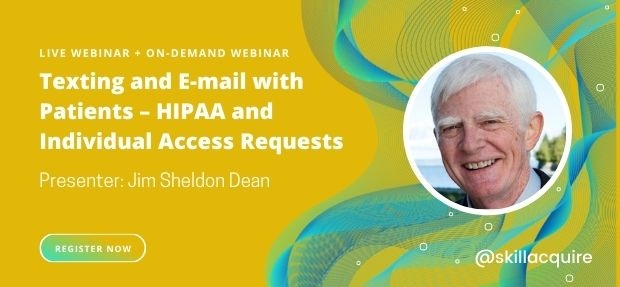YOUR CART
- No products in the cart.
Subtotal:
$0.00
BEST SELLING PRODUCTS

What is the issue and why is it important?
The use of texting and e-mail for communications with patients and between professionals is one of the most current issues in HIPAA compliance and enforcement. Providing appropriate access is one of the cornerstones of HIPAA and has been identified as an area of serious non-compliance that has been targeted in the most recent round of HIPAA Audits, and is now the subject of proposed changes to HIPAA designed to ease patient access and sharing of Protected Health Information.
Proper evaluation and management of risks are also on the hot list for audits and enforcement, and that includes considering communications appropriately both with patients and for business purposes that may or may not contain Protected Health Information. In addition, extensive guidance from HHS about individual access of information makes clear many areas of the access rules that must be reviewed for compliance in every health care organization.
With the advent of texting and e-mail and their adoption by a wide swath of the public, and with increases in audits and enforcement actions following breaches, now is the time to ensure your organization meets the requirements of the regulations and meets the texting and e-mail communication needs and desires of its providers, staff, and patients. You need the proper privacy protections for health information, including documented policies and procedures on which your staff has been trained, as well as documentation of any actions taken pursuant to those policies and procedures.
The stakes are high – any improper exposure of PHI against the rules may result in a breach that must be reported to the individual and to the US Department of Health and Human Services, at great cost and with the potential to bring fines and other enforcement actions if a violation of rules is involved. Likewise, complaints by a patient if they are not afforded the access they desire can bring about HHS inquiries and enforcement actions, so it is essential to find the right balance of access and control.
In addition to HIPAA, there are impacts of the Telecommunications Protection Act (TCPA) that limit the use of cell phones and, by inference, texting or e-mail for payment and healthcare purposes unless consent is obtained, and there have been actions by CMS prohibiting using texting for physician orders, and using any kind of insecure texting among professionals when PHI is involved.
The session will discuss the requirements, the risks, and the issues of the increasing use of texting and e-mail for the patient and provider communications and provide a road map for how to use them safely and effectively, to increase the quality of health care and patient satisfaction.
Key Topic Areas:
Professional communications involving Protected Health Information must be conducted securely, according to guidance from HHS and any reasonable Risk Analysis required by the Security Rule, so any official communications must be carefully controlled to avoid breaches of PHI. But it’s not only the office staff and physicians who need to communicate; communications with patients are key to patient care today.
As HIPAA requirements for allowing patients, electronic access to their health information are now in effect, and as patients increasingly come to depend on electronic communications, there are new demands for communication via e-mail and texting. Patients don’t want to bother with secure Website-based solutions, they just want to use the tools they already use for communication, and they have a right to communicate how they wish. How can HIPAA requirements for privacy and security be reconciled with patient requests for information provided by e-mail and text messages? This session will discuss the differences between professional communications and patient communications, and how they must be treated to best serve patients, most efficiently enable communications, and remain within the bounds of HIPAA compliance.
This session will focus on the rights of individuals under HIPAA to communicate in the manner they desire, and how to decide what is an acceptable process for communicating with individuals. The session will explain how to discuss communications options with individuals so that you can best meet their needs and desires while preserving their rights under the rules. The 2016 guidance on individual access of information, as well as the proposed changes to the access rules, will be discussed.
Texting is often the preferred, or sometimes the only way of communicating with patients. Doctors and medical offices are finding that texting is far more flexible, convenient, and effective than paging, and patients want to be able to use short message texting for handling of appointments, updates, and the like, where even e-mail or the telephone would seem inconvenient. Communicating with patients’ cell phones via texting or voice call for purposes of payment or providing healthcare information requires consent, and using texting for official purposes still remains out-of-bounds for physician orders. These issues must be considered when evaluating the use of texting and e-mail for all kinds of communications.
In order to integrate the use of e-mail and texting into patient and professional communications, it is essential to perform the proper steps in an information security compliance process to evaluate and address the risks of using the technology. This session will describe the information security compliance process, how it works, and how it can help you decide how to integrate e-mail and texting into your organization in a compliant way. There has long been a HIPAA requirement for covered entities to do their best to meet the requests of their patients for particular modes of communication, and using e-mail or texting is no exception.